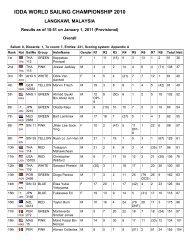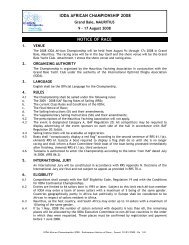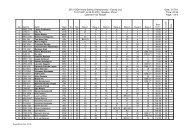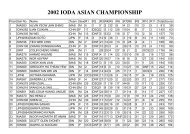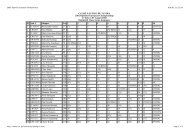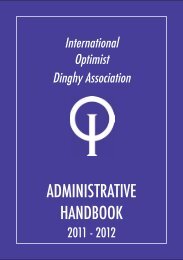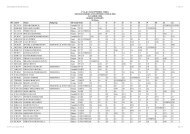2011 INTERNATIONAL OPTIMIST CLASS RULES
2011 INTERNATIONAL OPTIMIST CLASS RULES
2011 INTERNATIONAL OPTIMIST CLASS RULES
You also want an ePaper? Increase the reach of your titles
YUMPU automatically turns print PDFs into web optimized ePapers that Google loves.
2.7.5 The sail shall carry identification marks indicated in rule 6.5 and each sail manufactured<br />
or measured after January 1st 1990 shall have permanently fixed near its tack an officially<br />
numbered sail button. No sail shall be accepted for its first measurement without a<br />
sail button. Buttons shall not be transferred from one sail to another. Buttons shall normally<br />
be obtained from the International Optimist Dinghy Association (IODA) by the sailmakers<br />
but may also be obtained, if necessary, by National Class Associations.<br />
2.7.6 All emblems, plaques, marks and numbers shall be clearly legible, of durable material<br />
and shall be securely attached.<br />
2.8 Advertising<br />
The Optimist Class is Category A.<br />
As approved by the International Sailing Federation (ISAF), any National Owners<br />
Association with the consent of its Member National Authority (MNA) may permit full or<br />
restricted Category C for boats of that nation sailing in their national waters.<br />
Such advertising may relate to the ownership of the boat (i.e. may be restricted to club<br />
owned boats etc. only)<br />
3 CONSTRUCTION AND MEASUREMENT <strong>RULES</strong><br />
3.1 General<br />
3.1.1 All boats shall be built according to the Class Rules (see also CR 2.1.3). The dimensions<br />
and shape of the hull shall be as shown on the plans and as given in these rules, diagrams<br />
and measurement forms and shall conform with the tolerances stated therein.<br />
Materials shall be as specified in these Class Rules except that titanium, carbon fibre or<br />
other exotic materials are prohibited.<br />
3.1.2 Any attempt to concentrate the weight of the hull is prohibited.<br />
3.2 Hull<br />
3.2.1 Materials - GRP.<br />
For CR 3.2.1 for wood and wood/epoxy hulls, see Appendix A.<br />
3.2.1.1 The hull shall be constructed of materials approved by the ISAF. The following are the<br />
currently approved materials: Glass Reinforced Plastic (GRP).<br />
3.2.1.2 Hulls shall be constructed from:<br />
Mat 300 ( +/- 10% ) Mat 450 (+/- 10%)<br />
Woven Cloth or Biaxial 280 (+/-10%)<br />
Resin<br />
Bonding agent<br />
Gel coat<br />
Paint<br />
Foam core 13/60 ( +/-10% )<br />
Chopped strand mat of E glass fibres<br />
Cloth of woven or otherwise biaxial applied skeins of<br />
continuous E glass fibres<br />
Polyester resin for GRP lamination.<br />
Of any material to bond hull components and backing<br />
plates where appropriate.<br />
May be of any colour<br />
May be of any colour<br />
Durable, non-absorbent closed cell PVC foam which shall be<br />
bonded to the walls (see also CR 3.2.3.2)<br />
Mats & woven cloth are specified in grams per square metre +/- 10% (gr./m 2 )<br />
The E glass fibres and Polyester resin shall be transparent. Coloured fibres and resins<br />
are prohibited.<br />
6



